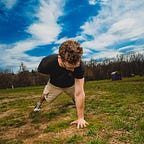How to Get Stronger (the RIGHT Way) with Bodyweight + Kettlebells
It’s no secret that kettlebells and bodyweight exercises go together like Batman and Robin, peanut butter and jelly, love and marriage, and just about any other “perfect pair” you can think of.
The reasons? There are two:
1) Bodyweight exercises teach you to master your body movements through free space
2) Kettlebell exercises teach you how to move both quickly and slowly with an awkward external load
What might still be a secret to you, however, is how to combine the two for maximum strength building in minimal time.
Unfortunately, the Zeitgeist of the day still views bodyweight and kettlebell exercises as mostly high-rep, low-technique activities for building endurance rather than disciplines that can be used to build real strength — and more importantly, UNreal strength, particularly when combined properly.
Techniques and programming details aside, there are a few major principles and practices of both disciplines that are absolute necessities for building brute strength in short order. A full list of principles would be quite long, so let’s take a look at the most important 3.
#1: Maximal speed in ballistics
This is one of the more overlooked ways of building strength with kettlebells, but it’s crucial. While most people treat kettlebell ballistics as conditioning movements only, nothing could be further from the truth.
The faster you can accelerate a weight, the more strength you can build. One reason many people don’t experience this is because they leave their ballistics for the end of their training sessions when they’re already tired and their explosive power is greatly reduced. Fight the urge to half-azz your kettlebell ballistics and you’ll likely notice a big increase in your strength and power.
#2: Maximal tension in ‘grinds’
A ‘grind’ is any movement you do relatively slowly (squat, press, deadlift, etc).
A common mistake among kettlebell enthusiasts is to use as little tension as necessary to lift a given weight, rather than learning to apply high-tension techniques with sub-maximal weights.
A common powerlifting axiom is “treat your light weights heavy so your heavy weights feel light”. This skill is one of the reasons why powerlifting and weightlifting athletes who only max out twice a year can build (and keep) such tremendous levels of strength for decades.
#3: Combine ballistics and grinds
While ballistics and grinds are often categorized as two different types of lifting, they both influence one another.
Ballistics teach you how to accelerate your grinds for stronger lifts, and grinds teach you how to maintain proper levels of tension in ballistic lifts.
Combining them in complexes, circuits, and chains helps you to blur the lines between the two and stack on more strength in less time.
The list could go on and on, but you get the picture.
The takeaway: Start sharpening your existing skills and you might start noticing an increase in your strength with very little change to your programming.
On that note, if you like training that:
- Gives you more strength than it takes from you
- Improves your stamina and resilience simultaneously
- Powers-up every nook, cranny, crevice, and corner of your Soft Machine
Then you just might like my 9-Minute Kettlebell and Bodyweight Challenge.
As the name indicates, it’s just 9 minutes long, and it’s designed to be done WITH your current workouts — NOT instead of them.
Even cooler:
Many find that it actually amplifies their strength in their favorite kettlebell and bodyweight moves, like presses, squats, pullups, and more.
And best of all, it’s free.
How free?
I’m talkin’ freer than the 4th of July, my friend.
Get thee thine own copy here => http://www.9MinuteChallenge.com
Have fun and happy training!
Aleks Salkin
